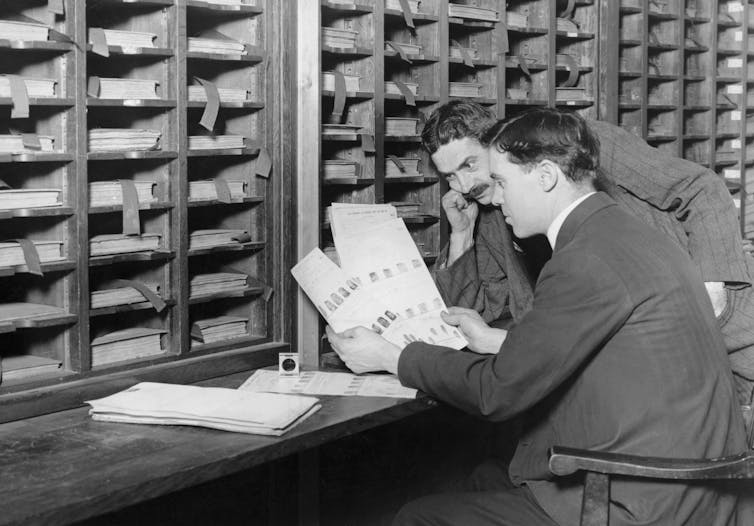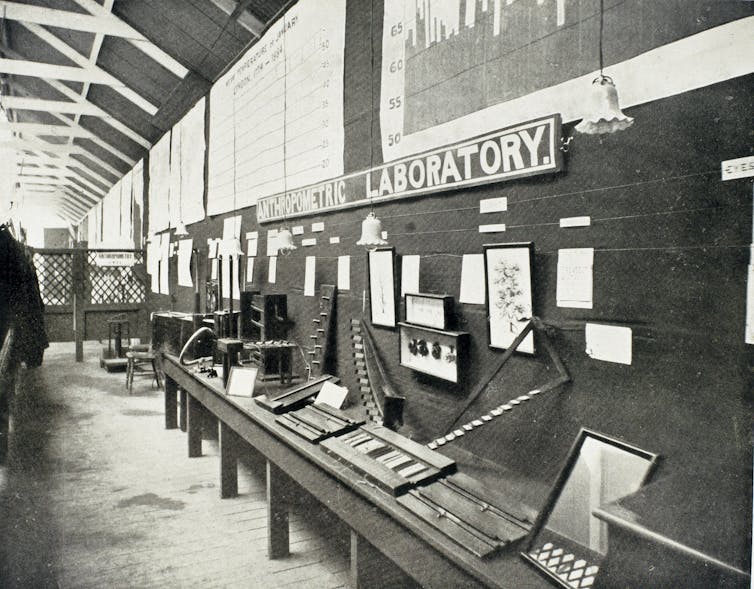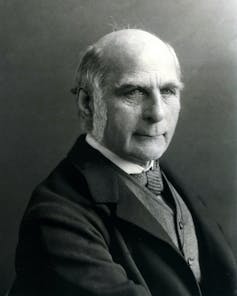Francis Galton pioneered scientific advances in many fields – but also founded the racist pseudoscience of eugenics
- Written by Richard Gunderman, Chancellor's Professor of Medicine, Liberal Arts, and Philanthropy, Indiana University
A popular pseudoscience was leaving its mark on American culture a century ago in everything from massive reductions[1] in quotas for immigration to the U.S., to thousands of “fitter family” contests[2] at county fairs, to a growing acceptance of birth control[3] by those who thought it could curtail the fertility of “undesirables.”
These are just a few examples of the influence of eugenics in the early 20th century. The idea of scientist Francis Galton, eugenics suggested that negative traits could be bred out of the human species by discouraging reproduction by those considered inferior. It laid the groundwork for forced sterilization laws[4] in the U.S. and Nazi “racial hygiene”[5] programs and the Holocaust.
While Galton is primarily remembered today, 110 years after his death, as the father of the shameful pseudoscience of eugenics, during his life he was considered one of the most influential thinkers of his day. He made seminal contributions in fields as diverse as statistics, geology, meteorology, anthropology, psychology, biology and psychometrics. My interest in Galton was renewed through my university’s decision to remove from buildings the name of one of its past presidents – David Starr Jordan[6] – who also happened to be a eugenicist.
Scientific contributions
Galton was a pioneer in meteorology, the study of weather. His 1863 book “Meteorographica[7]” was the first to describe weather on a continental scale. He developed instruments for measuring different weather parameters, described the use of barometric pressure in weather prediction, and devised systems for recording weather information. He published the world’s first weather map[8] in a newspaper, showing the reported weather in England on March 31, 1875.
Galton was an innovator in the field of statistics, the first to recognize the “wisdom of the crowd.” He once attended a livestock fair where villagers were asked to guess the weight of an ox. Nearly 800 people participated. When Galton looked at their estimates, he found that while almost all the guesses were wrong, both the middle guess and the average of the guesses were almost exactly correct. From such observations he helped to develop[9] the concepts of mean and variation, leading him to formulate the essential statistical concept of standard deviation.
 Scotland Yard detectives pore over fingerprints.
Bettmann via Getty Images[10]
Scotland Yard detectives pore over fingerprints.
Bettmann via Getty Images[10]
Galton helped forge a new science of forensics. Fortune tellers[11] and others had long scrutinized the lines and creases on the palms and fingers, which had been described in general terms by scientists and physicians. But Galton was the first to suggest that they could be the basis for a new science that he called dermatoglyphics – or “skin carvings.” Galton demonstrated that fingerprints are unique[12], stable over a lifetime, and could be classified and used to identify individuals who had left prints at the scene of a crime. Scotland Yard adopted his system.
Galton used scientific inquiry to investigate what proponents of religion had long preached was the power of prayer[13]. Reasoning that if prayer works, it should be possible to measure its effects, Galton set out to discover “whether those who pray attain their objects more frequently[14] than those who do not.” In 1872, he published “Statistical Inquiries into the Efficacy of Prayer,” in which he found that prayer produces no measurable difference in outcomes. This conclusion is supported, he argued, by the fact that insurance companies take no interest when setting their rates in whether their clients pray or not.
 Galton’s laboratory at the International Health Exhibition at the South Kensington Museum.
Science & Society Picture Library via Getty Images[15]
Galton’s laboratory at the International Health Exhibition at the South Kensington Museum.
Science & Society Picture Library via Getty Images[15]
Classifying and enhancing human beings
Galton founded the field that became known as psychometrics, the measurement of psychological faculties such as intelligence. One of Galton’s most famous works is “Hereditary Genius” (1870), in which he argues “each generation has enormous power over the natural gifts of those that follow[16].” If people would only direct a fraction of the time they spend on improving on cattle to the human race, he lamented, “what a galaxy of genius might we not create!”
Galton credited reading his cousin Charles Darwin’s “On the Origin of Species” (1859) about the theory of natural selection[17] with initiating him into “an entirely new province of knowledge[18],” paving the way for his studies of inheritance.
In 1884, Galton set up an “Anthropometric Laboratory[19]” at the International Health Exhibition in London. There he collected data on the physical characteristics and abilities of visiting members of the public. They paid to be measured, and he provided them with a copy of their data. He believed that such data could be used to compare individuals across different places of origin, residences, occupations, races and so on.
It was Galton who coined the term eugenics[20], from the Greek for “good stock.” He argued that the tendency of successful families to have few children relatively late in life was “dysgenic,” or bad for the stock, while capable people should be given incentive to marry early and have many children.
Galton thought he had discovered principles that would enhance human life, and he also spoke against what he regarded as “unreasonable” opposition to “the extinction of an inferior race.”
He himself had been born in 1822 into a prominent British family. He was a grandson of Erasmus Darwin, a physician, scientist and prominent abolitionist, and his family included multiple fellows of the Royal Society. His position of privilege likely influenced both his willingness to classify humankind into groups and his sense of what counted as good stock versus what sort of person belonged to an inferior race.
Long legacy of Galton’s eugenics
 Galton, around 1890.
adoc-photos/Corbis Historical via Getty Images[21]
Galton, around 1890.
adoc-photos/Corbis Historical via Getty Images[21]
Sir Francis Galton died in the U.K. on Jan. 17, 1911, but his work shaped government policies on both sides of the Atlantic for decades. Eugenics policies encouraged the most valued people to procreate in large numbers, while also aiming to prevent reproduction by those considered to be less fit.
Politicians including Theodore Roosevelt expressed the concern that failure of Anglo-Saxons to produce large families would result in “race suicide[22].” Many states enacted forced sterilization laws[23], later backed by a Supreme Court ruling[24] declaring that “Three generations of imbeciles are enough.”
As ethically faulty as eugenics was, Galton made errors in the science as well. Traits such as intelligence are not the expression of single genes[25], and the intelligence of children can differ markedly from that of their parents. Time after time, eugenicists promoted traits[26] such as blond hair and blue eyes that reflected not objectively superior attributes but their own mirror images. The Nazi genocide programs, aimed at promulgating a “master race[27],” opened many eyes to eugenics’ sinister implications.
[Deep knowledge, daily. Sign up for The Conversation’s newsletter[28].]
Today Galton’s star has fallen. This past summer, University College London announced that it was removing his name from a building[29], for instance, with his role as the father of eugenics far outweighing his other scientific contributions.
Yet Galton’s legacy has not entirely vanished. It was recently announced that in Europe, the number of babies being born with Down syndrome[30] has fallen by half[31], the result of prenatal testing and selective pregnancy termination. People are still choosing who can and cannot be born based on genes.
References
- ^ massive reductions (www.eugenicsarchive.org)
- ^ fitter family” contests (www.eugenicsarchive.org)
- ^ birth control (www.pbs.org)
- ^ forced sterilization laws (www.npr.org)
- ^ Nazi “racial hygiene” (encyclopedia.ushmm.org)
- ^ David Starr Jordan (www.insidehighered.com)
- ^ Meteorographica (galton.org)
- ^ published the world’s first weather map (galton.org)
- ^ helped to develop (galton.org)
- ^ Bettmann via Getty Images (www.gettyimages.com)
- ^ Fortune tellers (www.thecrimson.com)
- ^ demonstrated that fingerprints are unique (www.criminaljustice.ny.gov)
- ^ power of prayer (www.washingtonpost.com)
- ^ attain their objects more frequently (galton.org)
- ^ Science & Society Picture Library via Getty Images (www.gettyimages.com)
- ^ natural gifts of those that follow (www.branchcollective.org)
- ^ theory of natural selection (www.nationalgeographic.org)
- ^ an entirely new province of knowledge (www.darwinproject.ac.uk)
- ^ Anthropometric Laboratory (galton.org)
- ^ coined the term eugenics (www.facinghistory.org)
- ^ adoc-photos/Corbis Historical via Getty Images (www.gettyimages.com)
- ^ race suicide (exhibits.hsl.virginia.edu)
- ^ forced sterilization laws (theconversation.com)
- ^ Supreme Court ruling (www.npr.org)
- ^ expression of single genes (www.nature.com)
- ^ eugenicists promoted traits (healthcare.utah.edu)
- ^ master race (www.pbs.org)
- ^ Sign up for The Conversation’s newsletter (theconversation.com)
- ^ removing his name from a building (www.ucl.ac.uk)
- ^ Down syndrome (www.cdc.gov)
- ^ fallen by half (www.sciencedaily.com)
Authors: Richard Gunderman, Chancellor's Professor of Medicine, Liberal Arts, and Philanthropy, Indiana University

